3rd Semester Mechanical Engineering Report: Hip Arthroplasty Analysis
VerifiedAdded on 2020/09/03
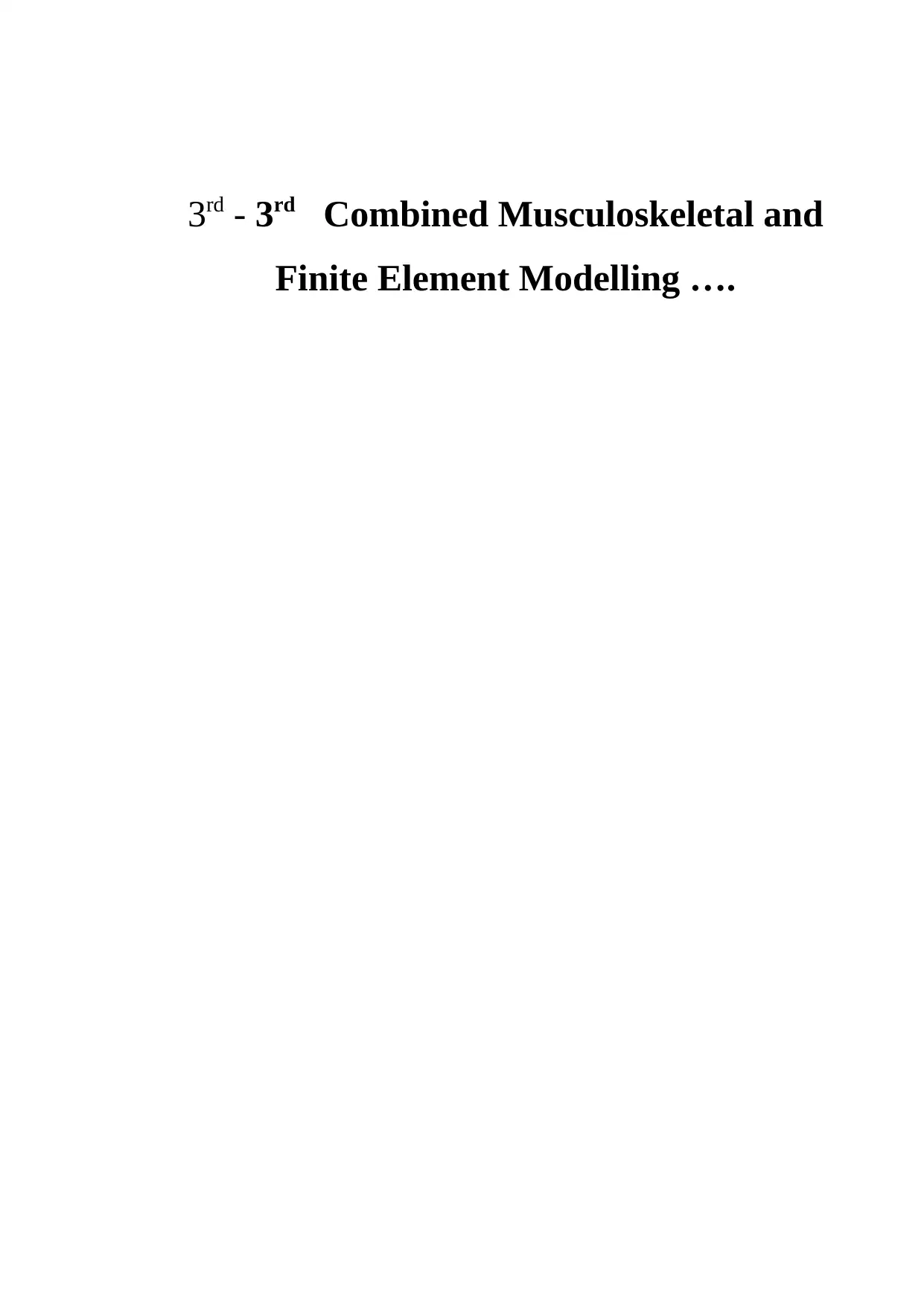
Finite Element Modelling ….
Paraphrase This Document

of the proximal femur
For the purpose of relief in hip-pain, the most successful procedure in terms of surgery
accounts to be Total hip arthroplasty. It also proves to be helpful in the restoring-function with
respect to joint and is further contributes in improving life quality (Bachmeier et al. 2001;
Karrholm et al. 2008). Despite the factor of enhancement in population, a very large amount of
patients are generally represented by even a small percentage of arthroplasty-surgeries that
have failed. From a total of 71,400 hip replacement which occurred in the year 2008, nearly
6,600 surgeries went through revision. This however occurred in the england &
Wales(National Joint Registry 2009). This obtained data is higher than the one recorded in the
year 2005 wherein from a total of 62,000 hip-replacements namely 5,800 revision were
observed (National Joint Registry 2005) . With reference to this data, the amount of people in
need of arthroplasty surgery is expected to increase (Birrell et al. 1999). There has been a
significant increase in the weight (National Joint Registry 2009) of patients as an outcome of
which their demographics have also changed. They are gradually becoming more young
(Karrholm et al. 2008) thereby tending to be rather active.
There are namely three categories wherein hip implants could be analysed. They are
clinical-trials in case of patients, modelling in computational style and in-vitro lab tests. For
the purpose of comparing three diversified implants, fixation methods, levels of activities
contextualising patients and even certain types of surgical procedures, gait analysis & reviews
that assess arthroplasty throughout the entire lifetime of patient can be utilised under clinical-
studies which are non-invasive. On the contrary, invasive processes like radiostereometric
analysis (RSA) wherein beads of tantalum are implanted as internal-markers around joint to be
replaced, can be of use for assessing patients as well as their implants. In order to obtain details
about the information regarding implant displacement , RSA can be referred. However, there is
an associated limitation as well. Only a selected set of patients would be taken in consideration
since the processes is of invasive nature & additionally expensive as well. Due to the studying
of patients within in-vivo, very dependable outcomes are obtained by the aid of clinical study.
Despite this, the flexibility of this clinical study is still in question due to the involvement of
ample confounding-variables that have potential. Adding more detail, in every study, only one
variable would be taken in consideration for investigation. In order to provide significant

requirement. For the purpose of finding out overall performance by a prosthesis, procedure or
hospital, the most suitable measure accounts to be revision of surgery. However, on the
contrary, in order to ascertain the entire performance of the hip that has been replaced, this
proves to be rather crude procedure. It has been found out that the life quality as well as pain-
levels would be measured by the aid of clinical studies (Karrholm et al. 2008). Despite this, the
process of assessing them is considered as very difficult.
Whenever a person begins to walk, the positioning of their legs get recorded by the aid of gait
analysis. By the utilisation of force-plate, the reaction of their foot upon ground gets recorded
(Section 3.2). In the duration of entire gate-cycle, joint angles could be calculated by using this
recorded data. Furthermore, to predict joint and muscle contact-forces, musculoskeletal model
can be taken into account (Section 3.3). For the purpose of comparing diversified hip
replacement that have occurred in total, utilisation of joint & muscle force could be done.
Despite this, another disadvantage is there that only a limited amount of individuals can be
assessed during the monitoring procedure of study. Ample of patients can be considered for
investigation for hip replacement since it is not an invasive study. In order for informing
experimental & computational analysation in hip replacements, a diversified range of forces
determined by musculoskeletal modelling in clinical study can be utilised.
The investigation of stability in case of an implant & wear upon bearing-surface are
assisted through laboratory experiments. A rather greater level of flexibility is aided through
this type of analysation in comparison to clinical study. The reason behind this is that implants
are available along with ample conditions for loading. These conditions of loading that are
going to be used in other tests need to be obtained from other study. Adding more to this, the
phenomenon of testing tends to be very expensive as well as slower in comparison to
computational-modelling. However, ample of design range, criteria for loading & scenarios
that have to be modelled is assisted by very flexible and quick in silica analyses (Section 3.2).
In this also, only limited data can be utilised and hence their validity is directly proportional to
load & input-geometry. Since vast of scenarios can be investigated by aid of this modelling
process, it is considered as good approach to examine trends. This will further assist for
investigation of the most appropriate and relevant situation. Afterwards these could be taken
into account for comparison with other experimental or clinical study. This is mainly for
evaluation of modelling process's robust nature.
⊘ This is a preview!⊘
Do you want full access?
Subscribe today to unlock all pages.

Trusted by 1+ million students worldwide
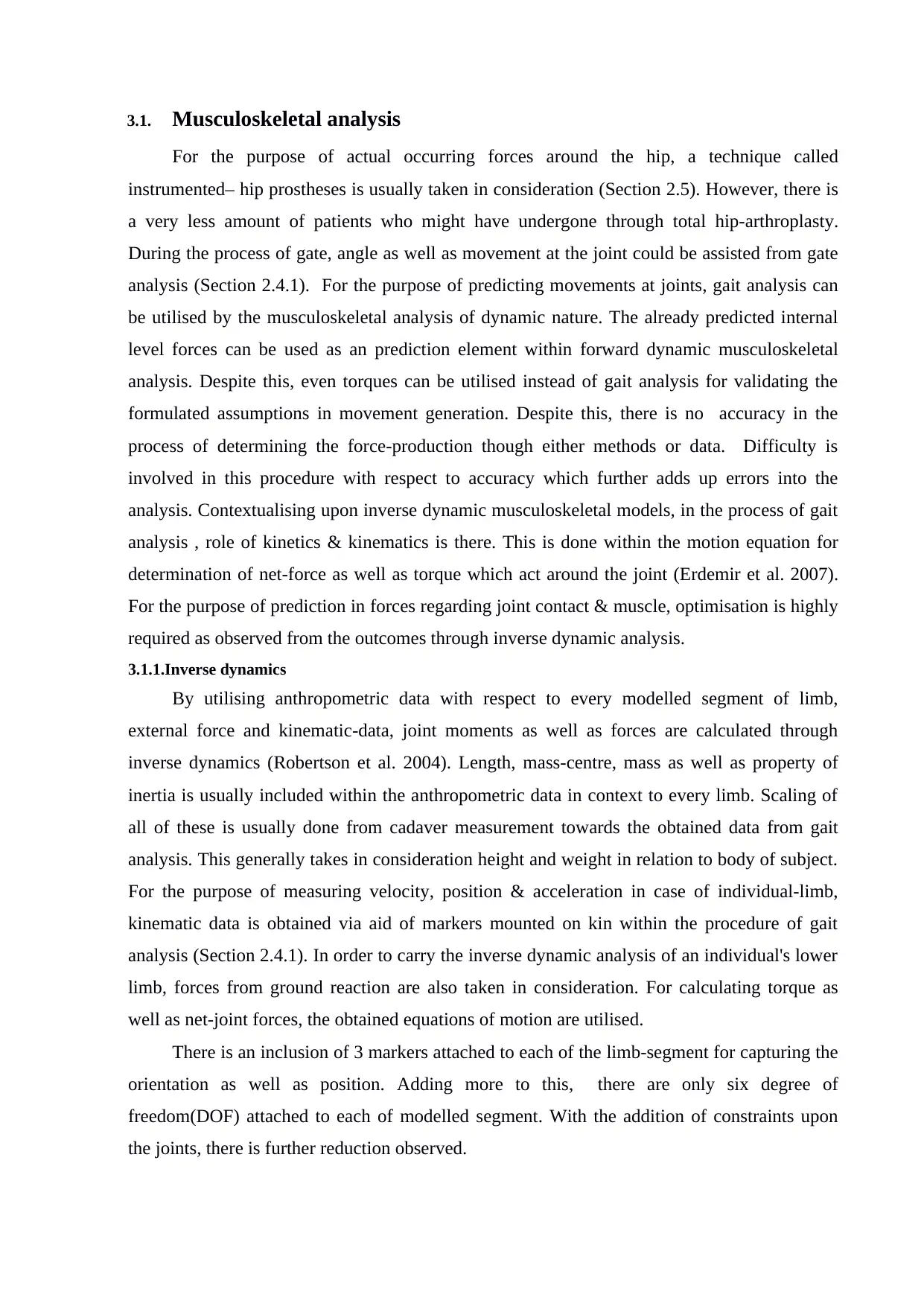
For the purpose of actual occurring forces around the hip, a technique called
instrumented– hip prostheses is usually taken in consideration (Section 2.5). However, there is
a very less amount of patients who might have undergone through total hip-arthroplasty.
During the process of gate, angle as well as movement at the joint could be assisted from gate
analysis (Section 2.4.1). For the purpose of predicting movements at joints, gait analysis can
be utilised by the musculoskeletal analysis of dynamic nature. The already predicted internal
level forces can be used as an prediction element within forward dynamic musculoskeletal
analysis. Despite this, even torques can be utilised instead of gait analysis for validating the
formulated assumptions in movement generation. Despite this, there is no accuracy in the
process of determining the force-production though either methods or data. Difficulty is
involved in this procedure with respect to accuracy which further adds up errors into the
analysis. Contextualising upon inverse dynamic musculoskeletal models, in the process of gait
analysis , role of kinetics & kinematics is there. This is done within the motion equation for
determination of net-force as well as torque which act around the joint (Erdemir et al. 2007).
For the purpose of prediction in forces regarding joint contact & muscle, optimisation is highly
required as observed from the outcomes through inverse dynamic analysis.
3.1.1.Inverse dynamics
By utilising anthropometric data with respect to every modelled segment of limb,
external force and kinematic-data, joint moments as well as forces are calculated through
inverse dynamics (Robertson et al. 2004). Length, mass-centre, mass as well as property of
inertia is usually included within the anthropometric data in context to every limb. Scaling of
all of these is usually done from cadaver measurement towards the obtained data from gait
analysis. This generally takes in consideration height and weight in relation to body of subject.
For the purpose of measuring velocity, position & acceleration in case of individual-limb,
kinematic data is obtained via aid of markers mounted on kin within the procedure of gait
analysis (Section 2.4.1). In order to carry the inverse dynamic analysis of an individual's lower
limb, forces from ground reaction are also taken in consideration. For calculating torque as
well as net-joint forces, the obtained equations of motion are utilised.
There is an inclusion of 3 markers attached to each of the limb-segment for capturing the
orientation as well as position. Adding more to this, there are only six degree of
freedom(DOF) attached to each of modelled segment. With the addition of constraints upon
the joints, there is further reduction observed.
Paraphrase This Document
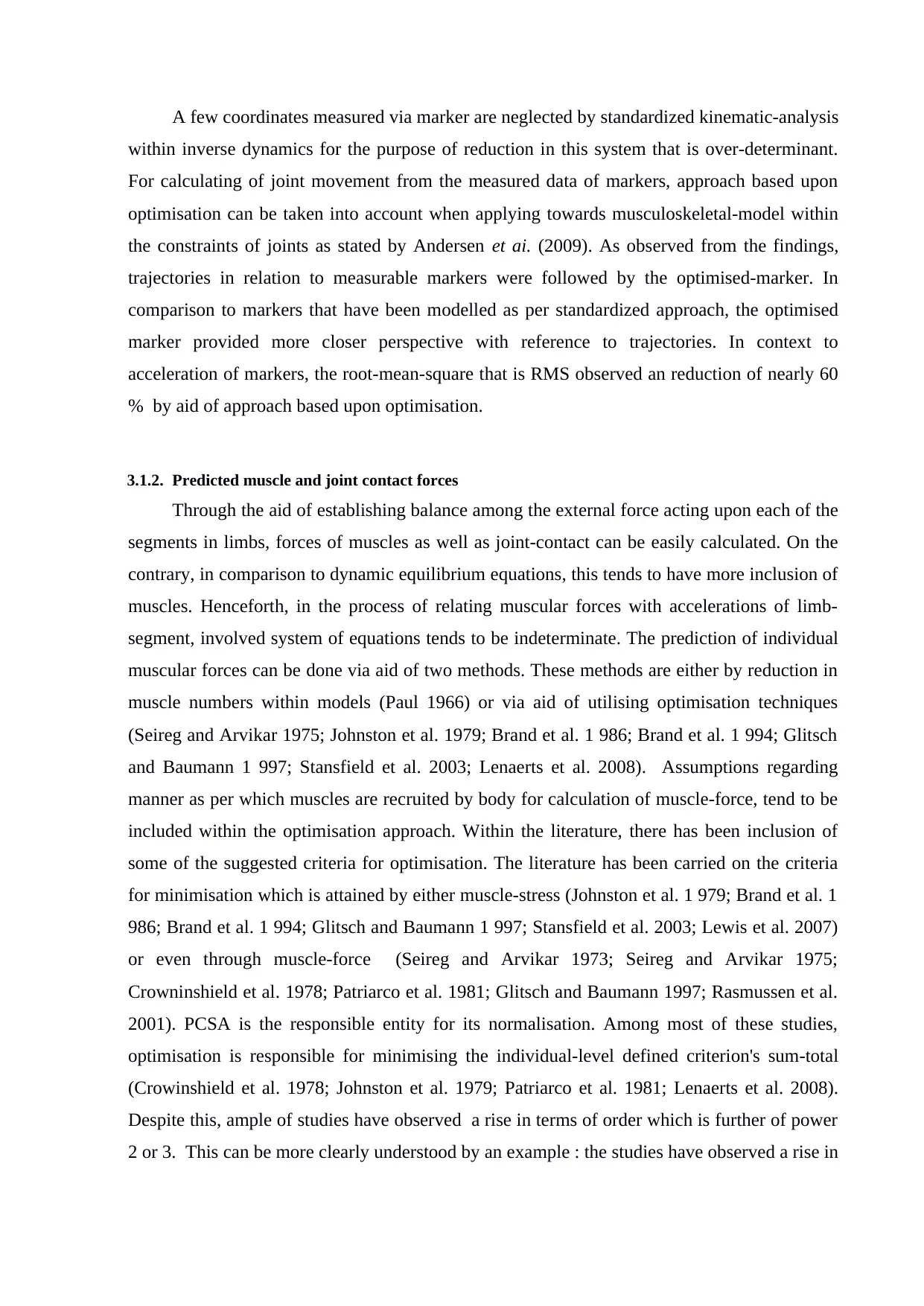
within inverse dynamics for the purpose of reduction in this system that is over-determinant.
For calculating of joint movement from the measured data of markers, approach based upon
optimisation can be taken into account when applying towards musculoskeletal-model within
the constraints of joints as stated by Andersen et ai. (2009). As observed from the findings,
trajectories in relation to measurable markers were followed by the optimised-marker. In
comparison to markers that have been modelled as per standardized approach, the optimised
marker provided more closer perspective with reference to trajectories. In context to
acceleration of markers, the root-mean-square that is RMS observed an reduction of nearly 60
% by aid of approach based upon optimisation.
3.1.2. Predicted muscle and joint contact forces
Through the aid of establishing balance among the external force acting upon each of the
segments in limbs, forces of muscles as well as joint-contact can be easily calculated. On the
contrary, in comparison to dynamic equilibrium equations, this tends to have more inclusion of
muscles. Henceforth, in the process of relating muscular forces with accelerations of limb-
segment, involved system of equations tends to be indeterminate. The prediction of individual
muscular forces can be done via aid of two methods. These methods are either by reduction in
muscle numbers within models (Paul 1966) or via aid of utilising optimisation techniques
(Seireg and Arvikar 1975; Johnston et al. 1979; Brand et al. 1 986; Brand et al. 1 994; Glitsch
and Baumann 1 997; Stansfield et al. 2003; Lenaerts et al. 2008). Assumptions regarding
manner as per which muscles are recruited by body for calculation of muscle-force, tend to be
included within the optimisation approach. Within the literature, there has been inclusion of
some of the suggested criteria for optimisation. The literature has been carried on the criteria
for minimisation which is attained by either muscle-stress (Johnston et al. 1 979; Brand et al. 1
986; Brand et al. 1 994; Glitsch and Baumann 1 997; Stansfield et al. 2003; Lewis et al. 2007)
or even through muscle-force (Seireg and Arvikar 1973; Seireg and Arvikar 1975;
Crowninshield et al. 1978; Patriarco et al. 1981; Glitsch and Baumann 1997; Rasmussen et al.
2001). PCSA is the responsible entity for its normalisation. Among most of these studies,
optimisation is responsible for minimising the individual-level defined criterion's sum-total
(Crowinshield et al. 1978; Johnston et al. 1979; Patriarco et al. 1981; Lenaerts et al. 2008).
Despite this, ample of studies have observed a rise in terms of order which is further of power
2 or 3. This can be more clearly understood by an example : the studies have observed a rise in

1 997; Hoek van Dijke et al. 1 999).
Van Bolhuis and Gielen (van Bolhuis and Gielen 1999) carried out the study in which
comparison was done of different techniques that are used for optimization. various models of
optimization were investigated by them by making comparison of the results of patterns of
electromyography (EMG) pertaining to the investigation of the arm that was carried out
through an isometric experiment. It was inferred from their research that there was no
similarity and association between the models investigated and the activation patterns derived
from EMG data. but, it was found that there was no fit between the minimization of either
metabolic consumption pf energy or sum of forces. The best match that was found for the
experimental data was that of the second order. This comprise of minimizing the sum of
squares of muscle activation, forces, stress.
For the purpose of validating their musculoskeletal model, measured hip-contact forces
were utilised by Brand et ai. (1994), Stansfield et ai. (2003) and Heller et ai. (2001). An
instrumented hip was utilised for comparison of hip-contact force with the separate gait
analysis which was recorded as measured by Brand et al. This was basically obtained from
the same patient as a result of which correlation of very good quality was able to be reported.
The muscle recruitment was utilised by them that further minimised muscle stress sum tht was
cubed. In comparison to the measured force upon heel-strike & peaks of toe-off, hip-contact
forces were predicted to be higher by approximately 0.5BW. Despite this, it is quite difficult to
assess the comparison's validity. The reason is due to the non-simultaneous hip-force
measurement as well as motion-capture. Adding more, there were also some recorded variation
in between the gait cycles. The data in context to gait analysis which was recorded in
simultaneous way along-with measured hip-contact forces by use of instrumented hip-implant
(Bergmann et al. 1993; 2001) was used by Stansfield et al. and Heller et al. From both the
studies, a very good quality of comparison was determined among the predicted & measured
hip-contact forces. In order to minimise sum of muscle-forces, muscle recruitment was utilised
by Heller et al. On the contrary before the reduction of forces in context to joint & muscle
forces, maximised muscle-stress was minimised by Stansfield et al. The hip-contact force is
generally better in stance in comparison to swing-phase as predicted by Heller et al. Although
slight overestimation was done in case of the predicted force. Nearly a deviation of 33% has
⊘ This is a preview!⊘
Do you want full access?
Subscribe today to unlock all pages.

Trusted by 1+ million students worldwide
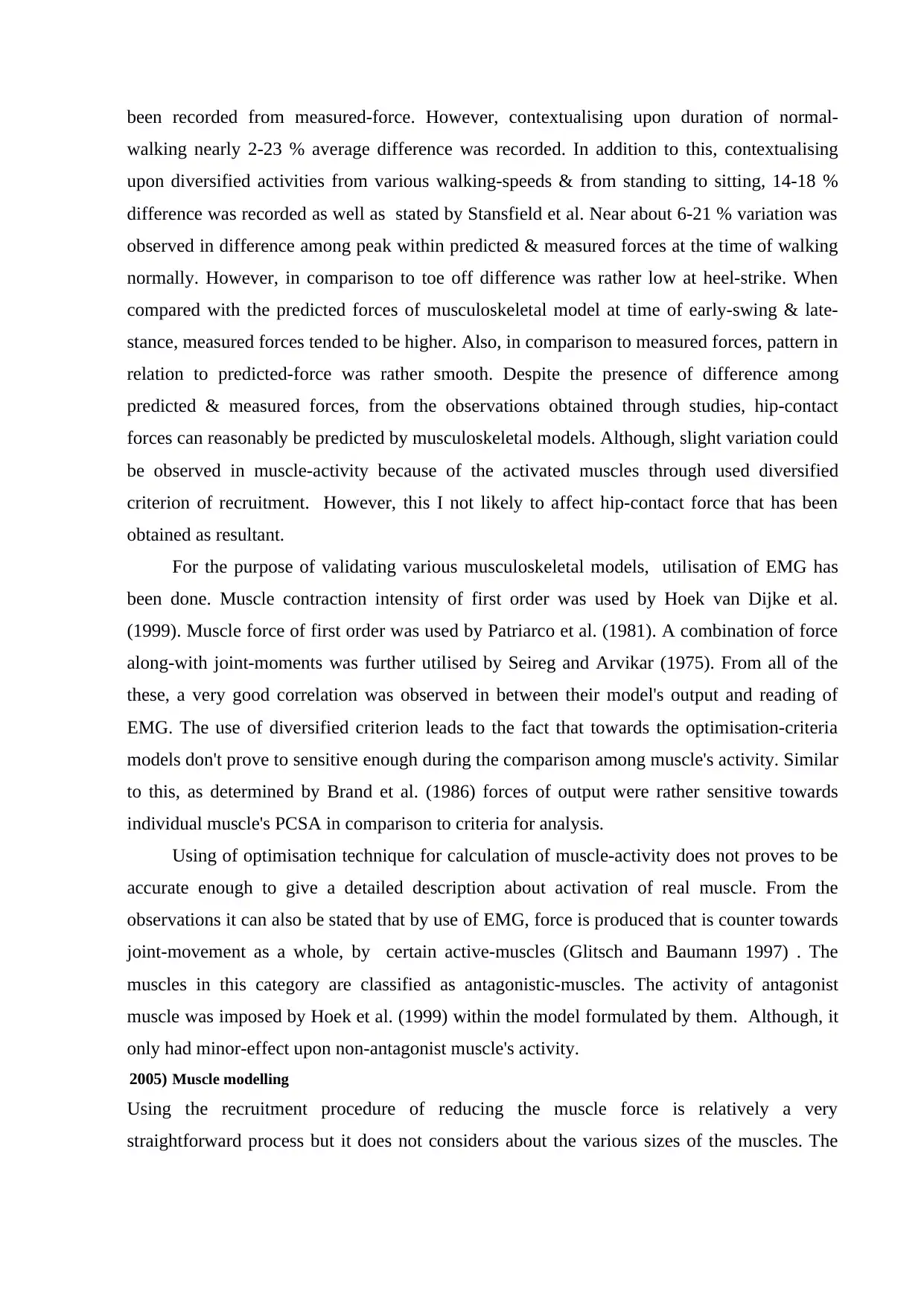
walking nearly 2-23 % average difference was recorded. In addition to this, contextualising
upon diversified activities from various walking-speeds & from standing to sitting, 14-18 %
difference was recorded as well as stated by Stansfield et al. Near about 6-21 % variation was
observed in difference among peak within predicted & measured forces at the time of walking
normally. However, in comparison to toe off difference was rather low at heel-strike. When
compared with the predicted forces of musculoskeletal model at time of early-swing & late-
stance, measured forces tended to be higher. Also, in comparison to measured forces, pattern in
relation to predicted-force was rather smooth. Despite the presence of difference among
predicted & measured forces, from the observations obtained through studies, hip-contact
forces can reasonably be predicted by musculoskeletal models. Although, slight variation could
be observed in muscle-activity because of the activated muscles through used diversified
criterion of recruitment. However, this I not likely to affect hip-contact force that has been
obtained as resultant.
For the purpose of validating various musculoskeletal models, utilisation of EMG has
been done. Muscle contraction intensity of first order was used by Hoek van Dijke et al.
(1999). Muscle force of first order was used by Patriarco et al. (1981). A combination of force
along-with joint-moments was further utilised by Seireg and Arvikar (1975). From all of the
these, a very good correlation was observed in between their model's output and reading of
EMG. The use of diversified criterion leads to the fact that towards the optimisation-criteria
models don't prove to sensitive enough during the comparison among muscle's activity. Similar
to this, as determined by Brand et al. (1986) forces of output were rather sensitive towards
individual muscle's PCSA in comparison to criteria for analysis.
Using of optimisation technique for calculation of muscle-activity does not proves to be
accurate enough to give a detailed description about activation of real muscle. From the
observations it can also be stated that by use of EMG, force is produced that is counter towards
joint-movement as a whole, by certain active-muscles (Glitsch and Baumann 1997) . The
muscles in this category are classified as antagonistic-muscles. The activity of antagonist
muscle was imposed by Hoek et al. (1999) within the model formulated by them. Although, it
only had minor-effect upon non-antagonist muscle's activity.
2005) Muscle modelling
Using the recruitment procedure of reducing the muscle force is relatively a very
straightforward process but it does not considers about the various sizes of the muscles. The
Paraphrase This Document
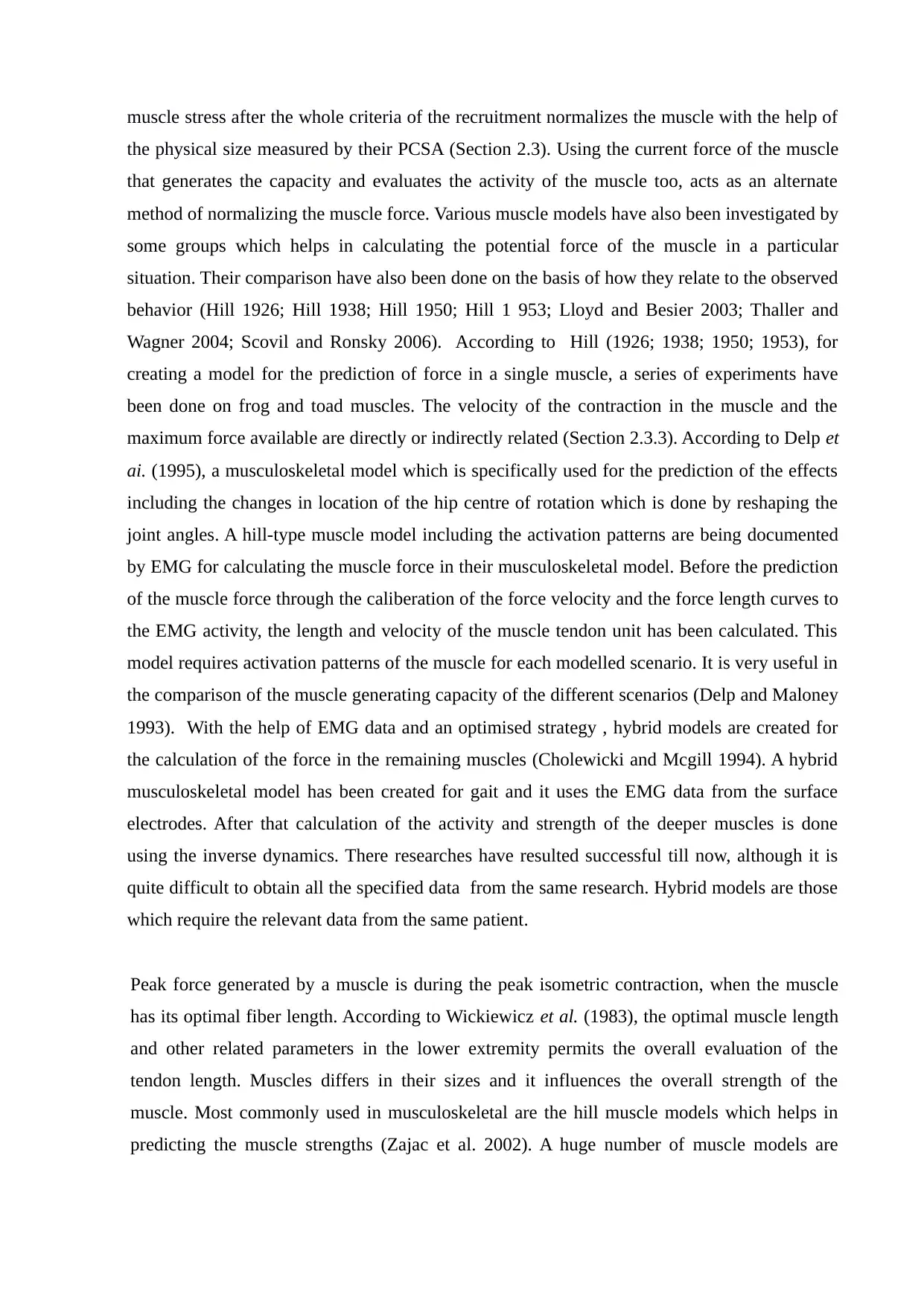
the physical size measured by their PCSA (Section 2.3). Using the current force of the muscle
that generates the capacity and evaluates the activity of the muscle too, acts as an alternate
method of normalizing the muscle force. Various muscle models have also been investigated by
some groups which helps in calculating the potential force of the muscle in a particular
situation. Their comparison have also been done on the basis of how they relate to the observed
behavior (Hill 1926; Hill 1938; Hill 1950; Hill 1 953; Lloyd and Besier 2003; Thaller and
Wagner 2004; Scovil and Ronsky 2006). According to Hill (1926; 1938; 1950; 1953), for
creating a model for the prediction of force in a single muscle, a series of experiments have
been done on frog and toad muscles. The velocity of the contraction in the muscle and the
maximum force available are directly or indirectly related (Section 2.3.3). According to Delp et
ai. (1995), a musculoskeletal model which is specifically used for the prediction of the effects
including the changes in location of the hip centre of rotation which is done by reshaping the
joint angles. A hill-type muscle model including the activation patterns are being documented
by EMG for calculating the muscle force in their musculoskeletal model. Before the prediction
of the muscle force through the caliberation of the force velocity and the force length curves to
the EMG activity, the length and velocity of the muscle tendon unit has been calculated. This
model requires activation patterns of the muscle for each modelled scenario. It is very useful in
the comparison of the muscle generating capacity of the different scenarios (Delp and Maloney
1993). With the help of EMG data and an optimised strategy , hybrid models are created for
the calculation of the force in the remaining muscles (Cholewicki and Mcgill 1994). A hybrid
musculoskeletal model has been created for gait and it uses the EMG data from the surface
electrodes. After that calculation of the activity and strength of the deeper muscles is done
using the inverse dynamics. There researches have resulted successful till now, although it is
quite difficult to obtain all the specified data from the same research. Hybrid models are those
which require the relevant data from the same patient.
Peak force generated by a muscle is during the peak isometric contraction, when the muscle
has its optimal fiber length. According to Wickiewicz et al. (1983), the optimal muscle length
and other related parameters in the lower extremity permits the overall evaluation of the
tendon length. Muscles differs in their sizes and it influences the overall strength of the
muscle. Most commonly used in musculoskeletal are the hill muscle models which helps in
predicting the muscle strengths (Zajac et al. 2002). A huge number of muscle models are
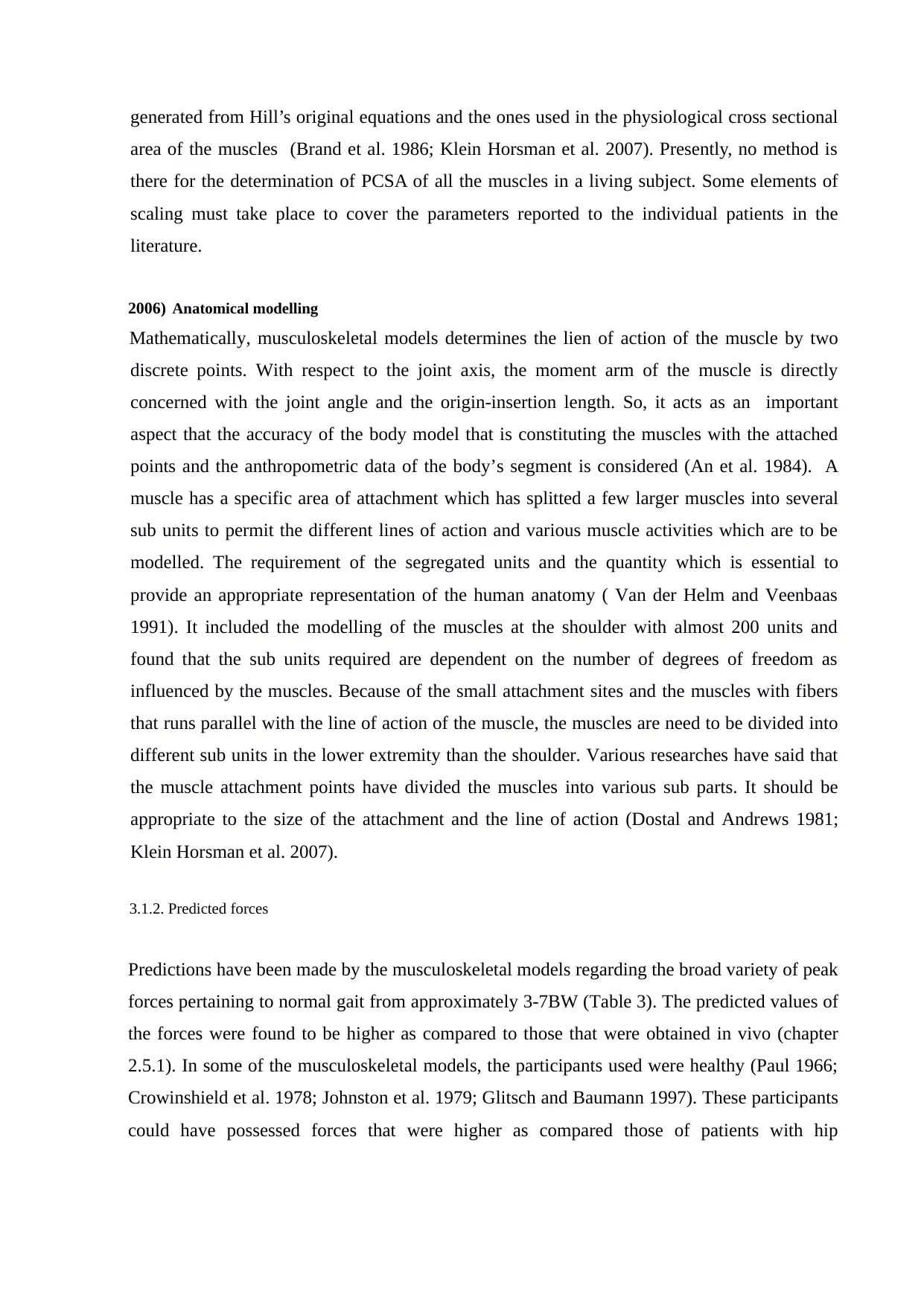
area of the muscles (Brand et al. 1986; Klein Horsman et al. 2007). Presently, no method is
there for the determination of PCSA of all the muscles in a living subject. Some elements of
scaling must take place to cover the parameters reported to the individual patients in the
literature.
2006) Anatomical modelling
Mathematically, musculoskeletal models determines the lien of action of the muscle by two
discrete points. With respect to the joint axis, the moment arm of the muscle is directly
concerned with the joint angle and the origin-insertion length. So, it acts as an important
aspect that the accuracy of the body model that is constituting the muscles with the attached
points and the anthropometric data of the body’s segment is considered (An et al. 1984). A
muscle has a specific area of attachment which has splitted a few larger muscles into several
sub units to permit the different lines of action and various muscle activities which are to be
modelled. The requirement of the segregated units and the quantity which is essential to
provide an appropriate representation of the human anatomy ( Van der Helm and Veenbaas
1991). It included the modelling of the muscles at the shoulder with almost 200 units and
found that the sub units required are dependent on the number of degrees of freedom as
influenced by the muscles. Because of the small attachment sites and the muscles with fibers
that runs parallel with the line of action of the muscle, the muscles are need to be divided into
different sub units in the lower extremity than the shoulder. Various researches have said that
the muscle attachment points have divided the muscles into various sub parts. It should be
appropriate to the size of the attachment and the line of action (Dostal and Andrews 1981;
Klein Horsman et al. 2007).
3.1.2. Predicted forces
Predictions have been made by the musculoskeletal models regarding the broad variety of peak
forces pertaining to normal gait from approximately 3-7BW (Table 3). The predicted values of
the forces were found to be higher as compared to those that were obtained in vivo (chapter
2.5.1). In some of the musculoskeletal models, the participants used were healthy (Paul 1966;
Crowinshield et al. 1978; Johnston et al. 1979; Glitsch and Baumann 1997). These participants
could have possessed forces that were higher as compared those of patients with hip
⊘ This is a preview!⊘
Do you want full access?
Subscribe today to unlock all pages.

Trusted by 1+ million students worldwide
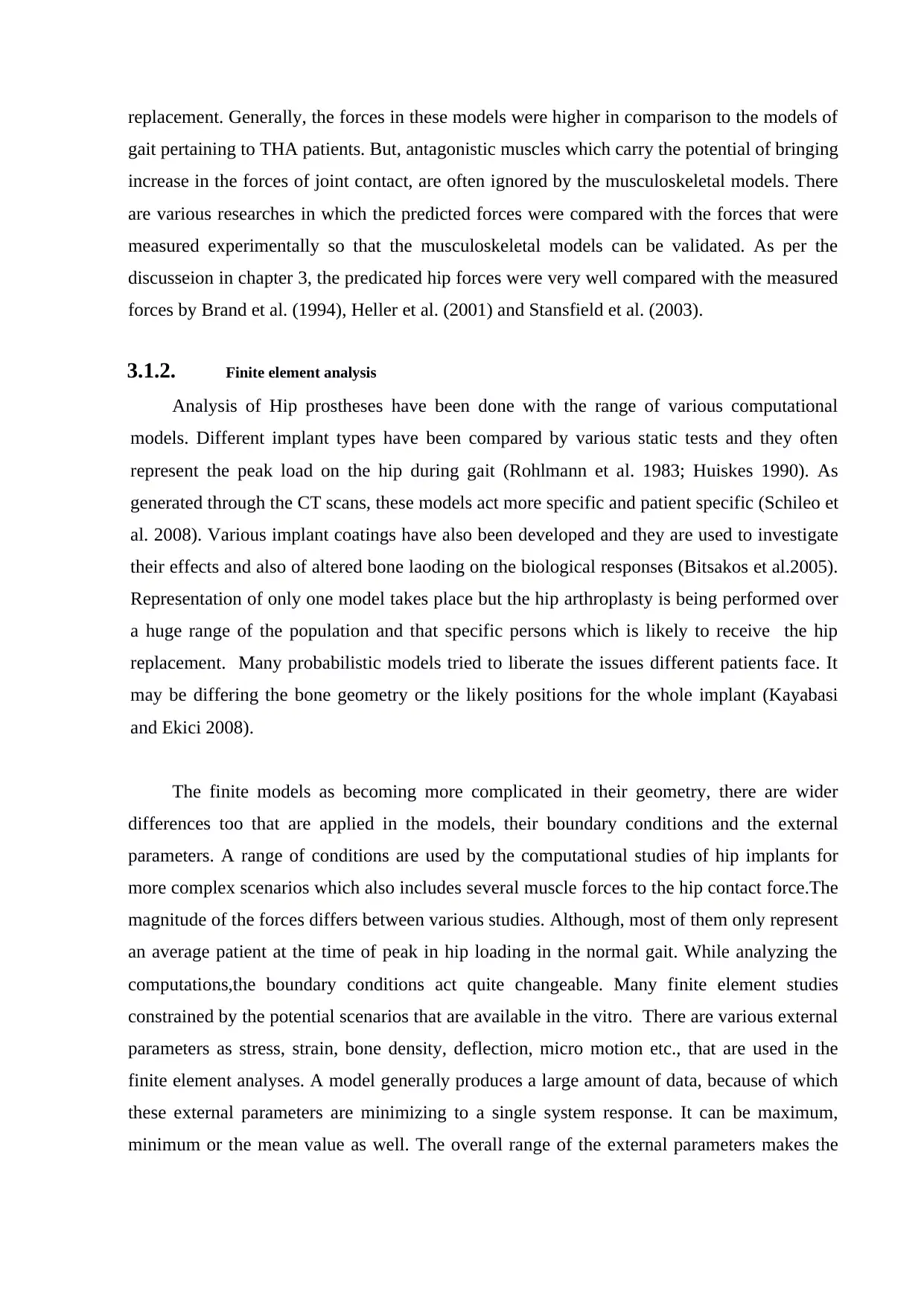
gait pertaining to THA patients. But, antagonistic muscles which carry the potential of bringing
increase in the forces of joint contact, are often ignored by the musculoskeletal models. There
are various researches in which the predicted forces were compared with the forces that were
measured experimentally so that the musculoskeletal models can be validated. As per the
discusseion in chapter 3, the predicated hip forces were very well compared with the measured
forces by Brand et al. (1994), Heller et al. (2001) and Stansfield et al. (2003).
3.1.2. Finite element analysis
Analysis of Hip prostheses have been done with the range of various computational
models. Different implant types have been compared by various static tests and they often
represent the peak load on the hip during gait (Rohlmann et al. 1983; Huiskes 1990). As
generated through the CT scans, these models act more specific and patient specific (Schileo et
al. 2008). Various implant coatings have also been developed and they are used to investigate
their effects and also of altered bone laoding on the biological responses (Bitsakos et al.2005).
Representation of only one model takes place but the hip arthroplasty is being performed over
a huge range of the population and that specific persons which is likely to receive the hip
replacement. Many probabilistic models tried to liberate the issues different patients face. It
may be differing the bone geometry or the likely positions for the whole implant (Kayabasi
and Ekici 2008).
The finite models as becoming more complicated in their geometry, there are wider
differences too that are applied in the models, their boundary conditions and the external
parameters. A range of conditions are used by the computational studies of hip implants for
more complex scenarios which also includes several muscle forces to the hip contact force.The
magnitude of the forces differs between various studies. Although, most of them only represent
an average patient at the time of peak in hip loading in the normal gait. While analyzing the
computations,the boundary conditions act quite changeable. Many finite element studies
constrained by the potential scenarios that are available in the vitro. There are various external
parameters as stress, strain, bone density, deflection, micro motion etc., that are used in the
finite element analyses. A model generally produces a large amount of data, because of which
these external parameters are minimizing to a single system response. It can be maximum,
minimum or the mean value as well. The overall range of the external parameters makes the
Paraphrase This Document
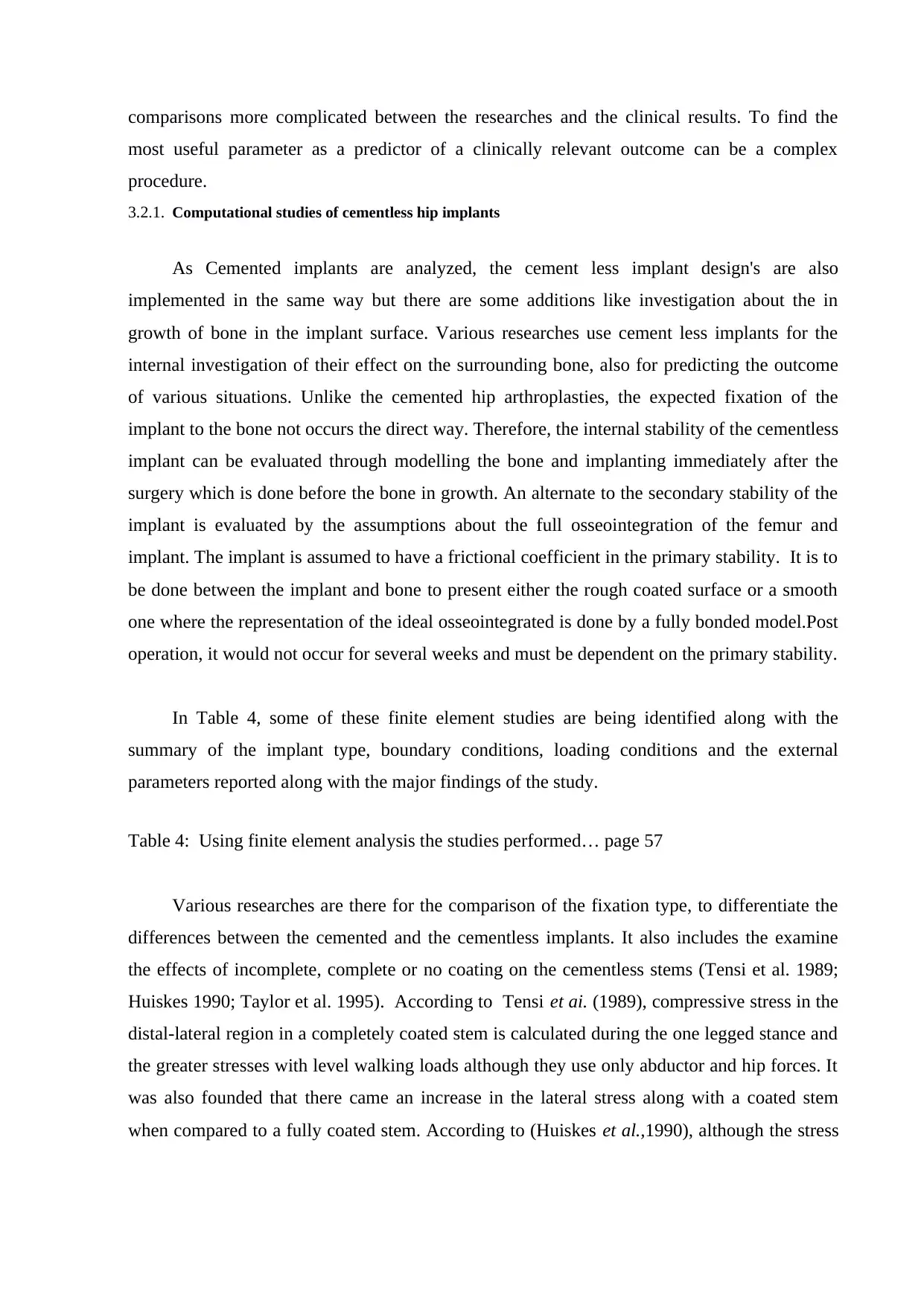
most useful parameter as a predictor of a clinically relevant outcome can be a complex
procedure.
3.2.1. Computational studies of cementless hip implants
As Cemented implants are analyzed, the cement less implant design's are also
implemented in the same way but there are some additions like investigation about the in
growth of bone in the implant surface. Various researches use cement less implants for the
internal investigation of their effect on the surrounding bone, also for predicting the outcome
of various situations. Unlike the cemented hip arthroplasties, the expected fixation of the
implant to the bone not occurs the direct way. Therefore, the internal stability of the cementless
implant can be evaluated through modelling the bone and implanting immediately after the
surgery which is done before the bone in growth. An alternate to the secondary stability of the
implant is evaluated by the assumptions about the full osseointegration of the femur and
implant. The implant is assumed to have a frictional coefficient in the primary stability. It is to
be done between the implant and bone to present either the rough coated surface or a smooth
one where the representation of the ideal osseointegrated is done by a fully bonded model.Post
operation, it would not occur for several weeks and must be dependent on the primary stability.
In Table 4, some of these finite element studies are being identified along with the
summary of the implant type, boundary conditions, loading conditions and the external
parameters reported along with the major findings of the study.
Table 4: Using finite element analysis the studies performed… page 57
Various researches are there for the comparison of the fixation type, to differentiate the
differences between the cemented and the cementless implants. It also includes the examine
the effects of incomplete, complete or no coating on the cementless stems (Tensi et al. 1989;
Huiskes 1990; Taylor et al. 1995). According to Tensi et ai. (1989), compressive stress in the
distal-lateral region in a completely coated stem is calculated during the one legged stance and
the greater stresses with level walking loads although they use only abductor and hip forces. It
was also founded that there came an increase in the lateral stress along with a coated stem
when compared to a fully coated stem. According to (Huiskes et al.,1990), although the stress
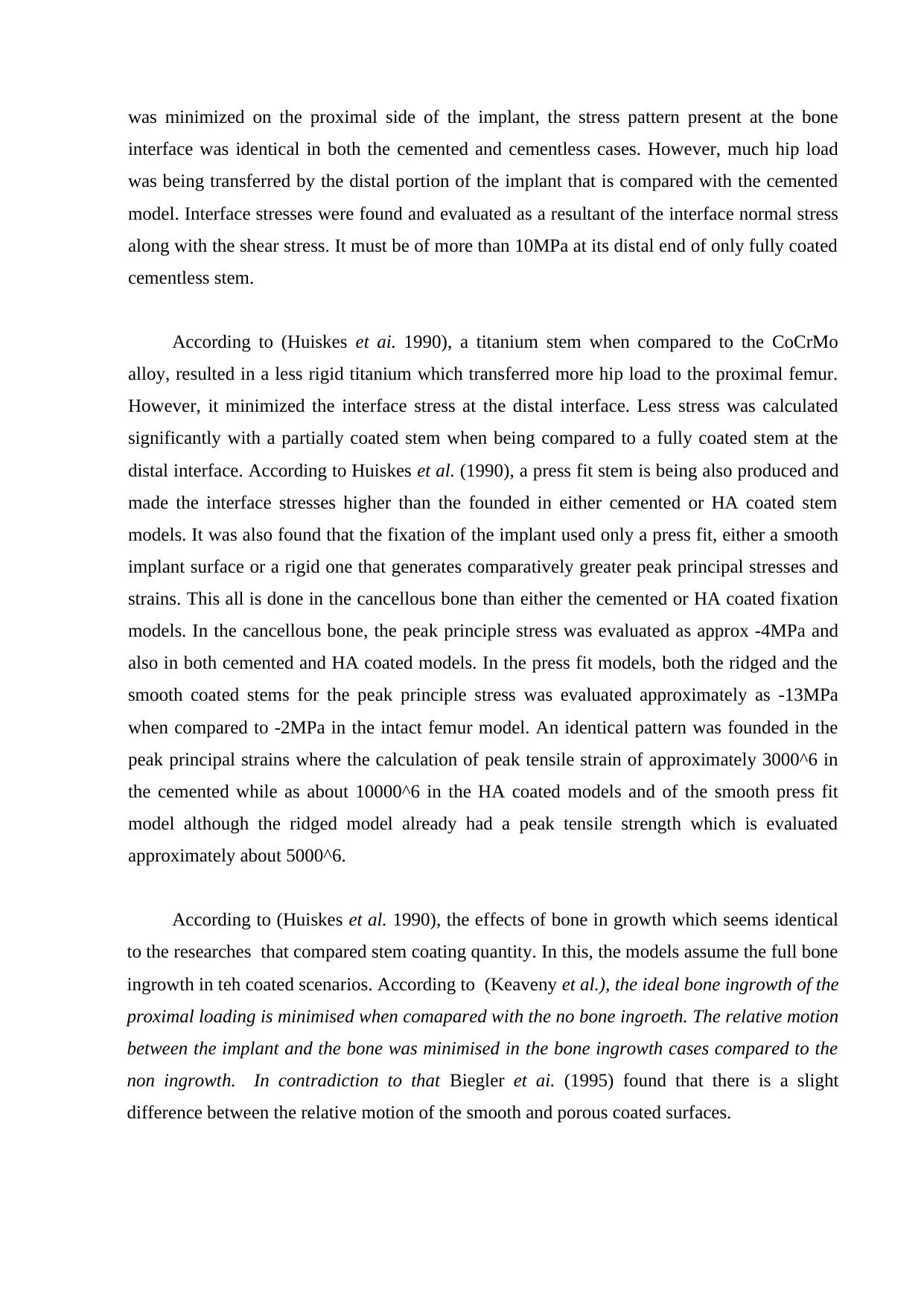
interface was identical in both the cemented and cementless cases. However, much hip load
was being transferred by the distal portion of the implant that is compared with the cemented
model. Interface stresses were found and evaluated as a resultant of the interface normal stress
along with the shear stress. It must be of more than 10MPa at its distal end of only fully coated
cementless stem.
According to (Huiskes et ai. 1990), a titanium stem when compared to the CoCrMo
alloy, resulted in a less rigid titanium which transferred more hip load to the proximal femur.
However, it minimized the interface stress at the distal interface. Less stress was calculated
significantly with a partially coated stem when being compared to a fully coated stem at the
distal interface. According to Huiskes et al. (1990), a press fit stem is being also produced and
made the interface stresses higher than the founded in either cemented or HA coated stem
models. It was also found that the fixation of the implant used only a press fit, either a smooth
implant surface or a rigid one that generates comparatively greater peak principal stresses and
strains. This all is done in the cancellous bone than either the cemented or HA coated fixation
models. In the cancellous bone, the peak principle stress was evaluated as approx -4MPa and
also in both cemented and HA coated models. In the press fit models, both the ridged and the
smooth coated stems for the peak principle stress was evaluated approximately as -13MPa
when compared to -2MPa in the intact femur model. An identical pattern was founded in the
peak principal strains where the calculation of peak tensile strain of approximately 3000^6 in
the cemented while as about 10000^6 in the HA coated models and of the smooth press fit
model although the ridged model already had a peak tensile strength which is evaluated
approximately about 5000^6.
According to (Huiskes et al. 1990), the effects of bone in growth which seems identical
to the researches that compared stem coating quantity. In this, the models assume the full bone
ingrowth in teh coated scenarios. According to (Keaveny et al.), the ideal bone ingrowth of the
proximal loading is minimised when comapared with the no bone ingroeth. The relative motion
between the implant and the bone was minimised in the bone ingrowth cases compared to the
non ingrowth. In contradiction to that Biegler et ai. (1995) found that there is a slight
difference between the relative motion of the smooth and porous coated surfaces.
⊘ This is a preview!⊘
Do you want full access?
Subscribe today to unlock all pages.

Trusted by 1+ million students worldwide
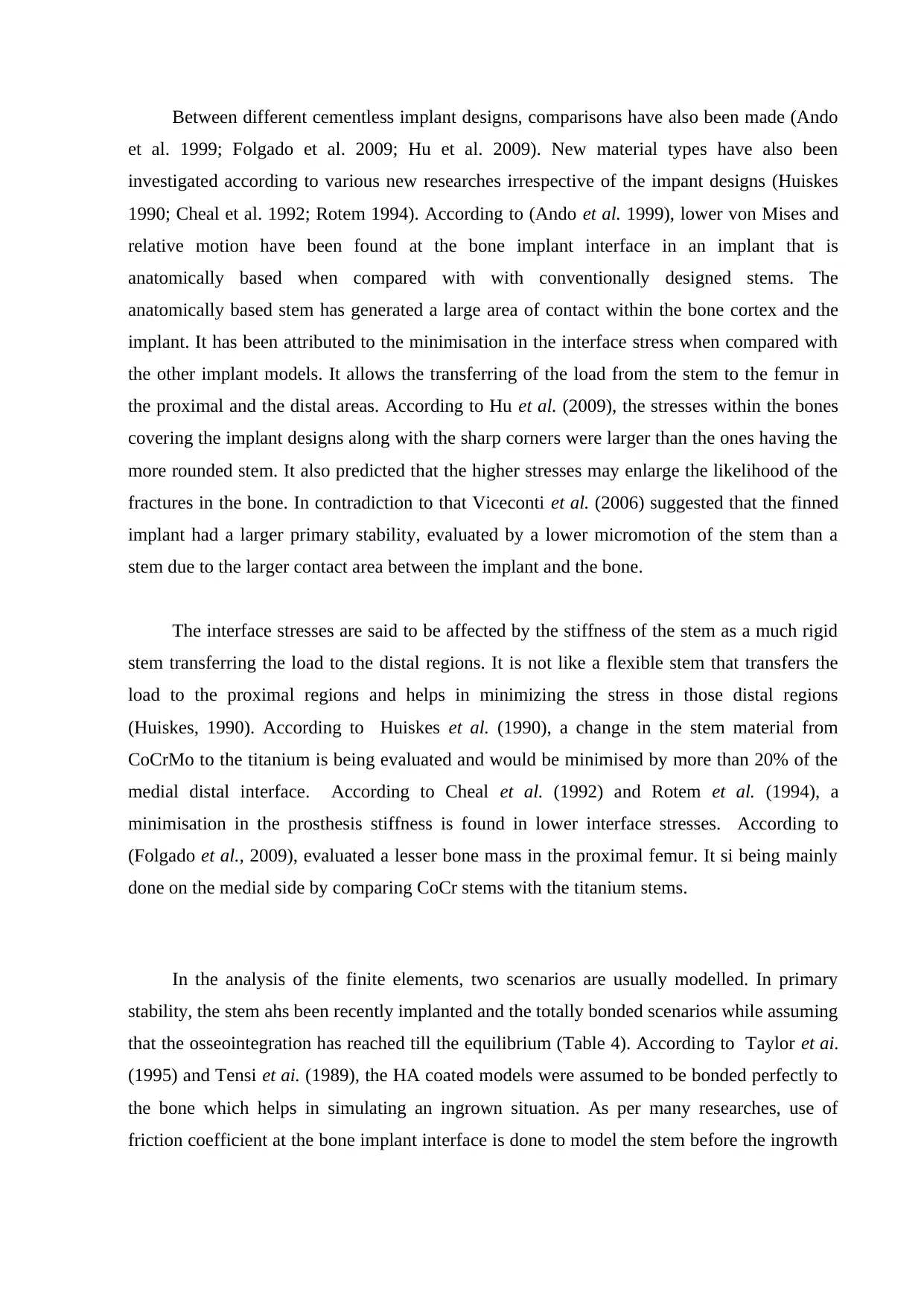
et al. 1999; Folgado et al. 2009; Hu et al. 2009). New material types have also been
investigated according to various new researches irrespective of the impant designs (Huiskes
1990; Cheal et al. 1992; Rotem 1994). According to (Ando et al. 1999), lower von Mises and
relative motion have been found at the bone implant interface in an implant that is
anatomically based when compared with with conventionally designed stems. The
anatomically based stem has generated a large area of contact within the bone cortex and the
implant. It has been attributed to the minimisation in the interface stress when compared with
the other implant models. It allows the transferring of the load from the stem to the femur in
the proximal and the distal areas. According to Hu et al. (2009), the stresses within the bones
covering the implant designs along with the sharp corners were larger than the ones having the
more rounded stem. It also predicted that the higher stresses may enlarge the likelihood of the
fractures in the bone. In contradiction to that Viceconti et al. (2006) suggested that the finned
implant had a larger primary stability, evaluated by a lower micromotion of the stem than a
stem due to the larger contact area between the implant and the bone.
The interface stresses are said to be affected by the stiffness of the stem as a much rigid
stem transferring the load to the distal regions. It is not like a flexible stem that transfers the
load to the proximal regions and helps in minimizing the stress in those distal regions
(Huiskes, 1990). According to Huiskes et al. (1990), a change in the stem material from
CoCrMo to the titanium is being evaluated and would be minimised by more than 20% of the
medial distal interface. According to Cheal et al. (1992) and Rotem et al. (1994), a
minimisation in the prosthesis stiffness is found in lower interface stresses. According to
(Folgado et al., 2009), evaluated a lesser bone mass in the proximal femur. It si being mainly
done on the medial side by comparing CoCr stems with the titanium stems.
In the analysis of the finite elements, two scenarios are usually modelled. In primary
stability, the stem ahs been recently implanted and the totally bonded scenarios while assuming
that the osseointegration has reached till the equilibrium (Table 4). According to Taylor et ai.
(1995) and Tensi et ai. (1989), the HA coated models were assumed to be bonded perfectly to
the bone which helps in simulating an ingrown situation. As per many researches, use of
friction coefficient at the bone implant interface is done to model the stem before the ingrowth
Paraphrase This Document

The calculation of micromotion is often carried out at the interface because the bone
growth at the surface can be impacted by it significantly. It can also affect the stability of the
implant (Jasty et al. 1991). According to the various researches conducted, it has been stated
that micromotion is inversely proportional to the surface of the stem in frictional contact which
represents the ingrown area (Keaveny and Bartel 1993; Keaveny and Bartel 1995). According
to the study conducted by Viceconti et al. micromotion is impacted by the thickness of the
layer of soft tissue, modelling of which was done with a low frictional coefficient. It was also
found that osteointegration on the surface of the implant could be prevented by a layer which
was greater than 500^m. The micromotion at the interface is also affected by the contact area
that lies between the bone and the stem (1999; 2006; 2008). Ando et al. (1999) found that with
an anatomically shaped stem, there was a lower relative motion in comparison to
conventionally shaped stems due to better fit between the bone and stem. Viceconti et al.
(2006) found that the contact region that lies between the stem and the bone significantly
impacted peak micromotion and Park et al. (2008) also explored that micromotion was reduced
if the gaps at the bone implant interface are reduced. This happens due to an increase in the
contact region. However, according to the study carried out by Park et al. (2009) at low ratios,
micromotion is affected by the bone-implant contact ratio. But, a contact greater than 40 per
cent does not affect micromotion significantly. Several research have been studied related to
bone growth and tissue differentiation beyond the analyze of independent static and the change
in tissue type based can be considered by making use of adaptive models on the loading of
respective elements. Folgado et al. (2009) in an adaptive model make use of bone strain to
bring out the comparison between the amount of coating on a stem and the material type. To
symbolize coated surfaces on hip stems a frictional coefficient of 0.6 was utilized and they
discovered that less amount of bone resorption are produced by uncoated stems in comparison
to partial and full coated stem models. Some past study have discovered that the lifespan of
uncoated stem is likely to be shorter due to high stresses at the interface (Huiskes 1 990;
Taylor et al. 1 995) and Folgado et ai. also discovered that uncoated stream have higher strain
at the interface however to calculate bone resorption an algorithm is used which uses the high
strain to remodel the bone density. They studied that the effect of coating for cylindrical and
the final bone mass was same in all the coating types whereas with a tapered stem. was less
when the stem was tapered .

of stem that showed an anteverted or medialised stem would produce higher strain across the
length of the femur in comparison with properly positioned stem. In particular, they
discovered that the medialised stem produces a higher strain energy density during stair
climbing tin comparison with reference stem position. However these differences that are
discovered are tiny in comparison to change in strain from an intact femur to an implanted
situation. Reggiani et al. (2008) also analyzed implant position impacts by examining a
planned stem position with the surgically achieved position. By examining these two models
only a slight difference was found although, at peak, discovered with the help of achieved
position there is an increase of 12% in the von Mises stresses.
A wide range of scenarios to be modeled by making use of Probabilistic studies
(Viceconti et al. 2006; Park et al. 2009; Dopico-Gonzalez et al. 2010). By varying the bone
density, patient’s body weight, bone size and the quantity of bone-implant contact area
Viceconti et al. (2006)analyzed 1000 models of an implanted cementless stem .They
discovered that due to total variation that was applied to the model and the average
micromotion 206±159^m under stair climbing loads the peak micromotion was affected. The
bone size, body weight and region of implant contact were found to significantly affect The
peak shear stress and peak micromotion were affected by the variation in cortical bone
density , bone size, body weight and region of implant contact . However, although the report
was varied with the body weight and it was then used to vary the loads on the femur, other
report have shown that body weight cannot be considered alone for inter-patient variation
(Bergmann et al. 2001; Taylor and Walker 2001). By making use of probabilistic model
Dopico-Gonzalez et ai. (2010) discovered that peak micromotion are affected by bone and
implant geometry at the bone-implant interface .The bone-implant interface area are affected
by implant geometry and as a outcome it has been discovered to change the micromotion
(Park et al. 2009). Park et al. (2009) found so that with an increase in contact ratio between the
implant and bone using a statistical model the bone-implant micromotion can getv reduced.
2007) The applied forces limitations in finite element studies
Despite the enhancement in modeling techniques, the previous finite element studied
shows the consideration of the loads acting across the hip joint have changed a little. Hip
⊘ This is a preview!⊘
Do you want full access?
Subscribe today to unlock all pages.

Trusted by 1+ million students worldwide
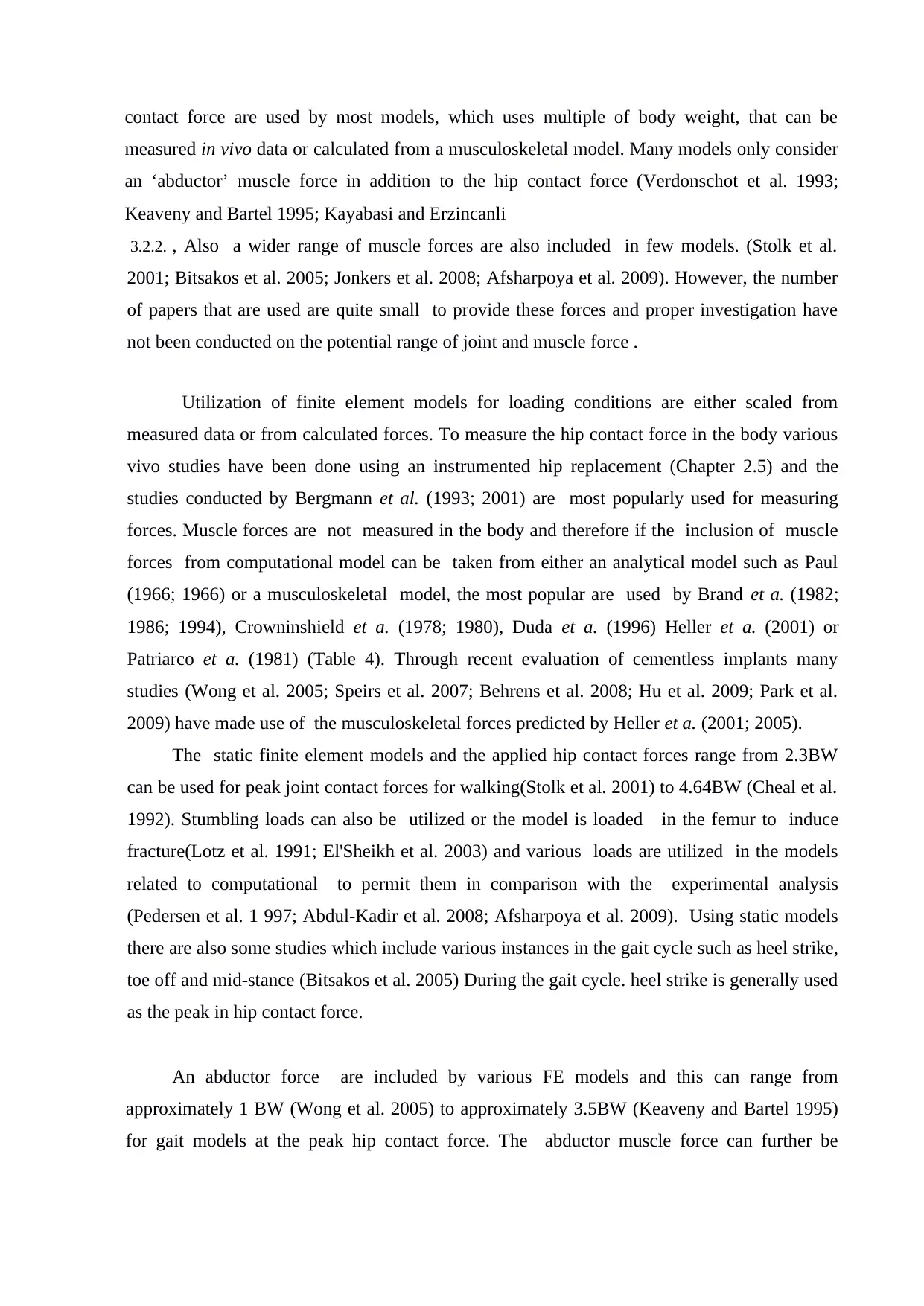
measured in vivo data or calculated from a musculoskeletal model. Many models only consider
an ‘abductor’ muscle force in addition to the hip contact force (Verdonschot et al. 1993;
Keaveny and Bartel 1995; Kayabasi and Erzincanli
3.2.2. , Also a wider range of muscle forces are also included in few models. (Stolk et al.
2001; Bitsakos et al. 2005; Jonkers et al. 2008; Afsharpoya et al. 2009). However, the number
of papers that are used are quite small to provide these forces and proper investigation have
not been conducted on the potential range of joint and muscle force .
Utilization of finite element models for loading conditions are either scaled from
measured data or from calculated forces. To measure the hip contact force in the body various
vivo studies have been done using an instrumented hip replacement (Chapter 2.5) and the
studies conducted by Bergmann et al. (1993; 2001) are most popularly used for measuring
forces. Muscle forces are not measured in the body and therefore if the inclusion of muscle
forces from computational model can be taken from either an analytical model such as Paul
(1966; 1966) or a musculoskeletal model, the most popular are used by Brand et a. (1982;
1986; 1994), Crowninshield et a. (1978; 1980), Duda et a. (1996) Heller et a. (2001) or
Patriarco et a. (1981) (Table 4). Through recent evaluation of cementless implants many
studies (Wong et al. 2005; Speirs et al. 2007; Behrens et al. 2008; Hu et al. 2009; Park et al.
2009) have made use of the musculoskeletal forces predicted by Heller et a. (2001; 2005).
The static finite element models and the applied hip contact forces range from 2.3BW
can be used for peak joint contact forces for walking(Stolk et al. 2001) to 4.64BW (Cheal et al.
1992). Stumbling loads can also be utilized or the model is loaded in the femur to induce
fracture(Lotz et al. 1991; El'Sheikh et al. 2003) and various loads are utilized in the models
related to computational to permit them in comparison with the experimental analysis
(Pedersen et al. 1 997; Abdul-Kadir et al. 2008; Afsharpoya et al. 2009). Using static models
there are also some studies which include various instances in the gait cycle such as heel strike,
toe off and mid-stance (Bitsakos et al. 2005) During the gait cycle. heel strike is generally used
as the peak in hip contact force.
An abductor force are included by various FE models and this can range from
approximately 1 BW (Wong et al. 2005) to approximately 3.5BW (Keaveny and Bartel 1995)
for gait models at the peak hip contact force. The abductor muscle force can further be
Paraphrase This Document
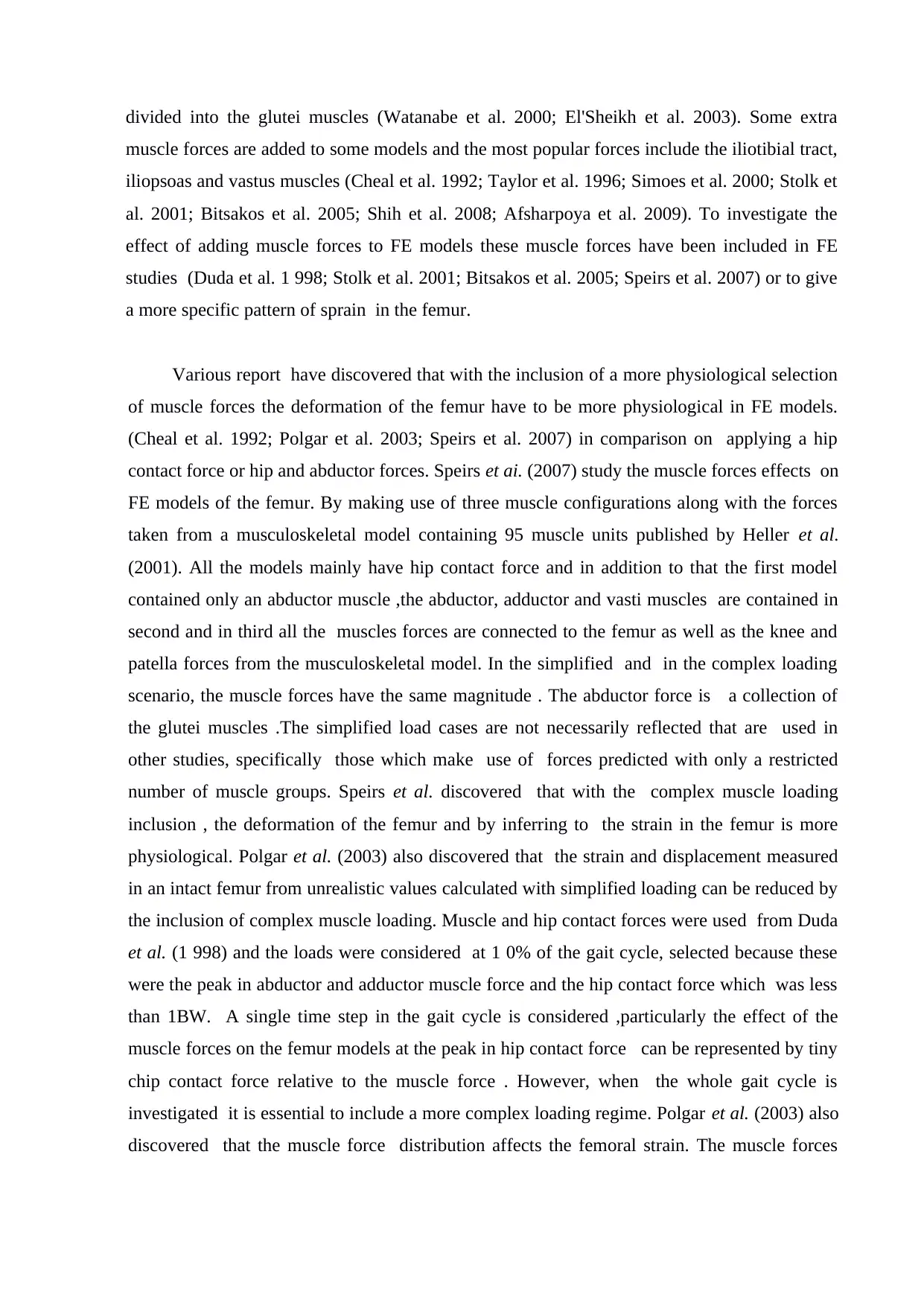
muscle forces are added to some models and the most popular forces include the iliotibial tract,
iliopsoas and vastus muscles (Cheal et al. 1992; Taylor et al. 1996; Simoes et al. 2000; Stolk et
al. 2001; Bitsakos et al. 2005; Shih et al. 2008; Afsharpoya et al. 2009). To investigate the
effect of adding muscle forces to FE models these muscle forces have been included in FE
studies (Duda et al. 1 998; Stolk et al. 2001; Bitsakos et al. 2005; Speirs et al. 2007) or to give
a more specific pattern of sprain in the femur.
Various report have discovered that with the inclusion of a more physiological selection
of muscle forces the deformation of the femur have to be more physiological in FE models.
(Cheal et al. 1992; Polgar et al. 2003; Speirs et al. 2007) in comparison on applying a hip
contact force or hip and abductor forces. Speirs et ai. (2007) study the muscle forces effects on
FE models of the femur. By making use of three muscle configurations along with the forces
taken from a musculoskeletal model containing 95 muscle units published by Heller et al.
(2001). All the models mainly have hip contact force and in addition to that the first model
contained only an abductor muscle ,the abductor, adductor and vasti muscles are contained in
second and in third all the muscles forces are connected to the femur as well as the knee and
patella forces from the musculoskeletal model. In the simplified and in the complex loading
scenario, the muscle forces have the same magnitude . The abductor force is a collection of
the glutei muscles .The simplified load cases are not necessarily reflected that are used in
other studies, specifically those which make use of forces predicted with only a restricted
number of muscle groups. Speirs et al. discovered that with the complex muscle loading
inclusion , the deformation of the femur and by inferring to the strain in the femur is more
physiological. Polgar et al. (2003) also discovered that the strain and displacement measured
in an intact femur from unrealistic values calculated with simplified loading can be reduced by
the inclusion of complex muscle loading. Muscle and hip contact forces were used from Duda
et al. (1 998) and the loads were considered at 1 0% of the gait cycle, selected because these
were the peak in abductor and adductor muscle force and the hip contact force which was less
than 1BW. A single time step in the gait cycle is considered ,particularly the effect of the
muscle forces on the femur models at the peak in hip contact force can be represented by tiny
chip contact force relative to the muscle force . However, when the whole gait cycle is
investigated it is essential to include a more complex loading regime. Polgar et al. (2003) also
discovered that the muscle force distribution affects the femoral strain. The muscle forces

comparison is done over the insertion area where the muscle forces are distributed uniformly.
The principal strain for peak tensile is reduced from approximately 9000^6 to approximately
1000^6 and the internal compressive and with the distributed model. principal strains for
tensiles also decreases Taylor et al. (1995) discovered an enchancement to the abductor,
iliotibial tract and iliopsoas forces to a hip contact force only
reduced the peak minimum principal stress slightly in the cancellous bone in an HA coated
implant model although in the intact femur model it reduced the peak minimum principal
stress to -0.75MPa which is less than a half the stress calculated by the hip contact force alone.
The influence of loading conditions was also investigated by Bitsakos et ai. (2005) and
to calculate bone loss in the femur after a hip arthroplasty made use of an adaptive models.
From a musculoskeletal model (Brand et al. 1994; Duda et al. 1996) their study also used a set
of muscle forces that were taken and reduced the number of muscles included in the FE study
without altering the magnitude of the remaining forces. They discovered that by using models
a smaller quantity of bone loss surrounding the femur can be calculated with the more realistic
set of muscles and this can be compared well with clinical data although they commented that
using the algorithm to calculate the bone remodelling over-estimates bone loss.
In an intact femur the effect on the strain pattern was also investigated in a finite
element model by Duda et al. (1998) with respect to the inclusion of muscle forces. Muscle
forces were used as they were predicted from a musculoskeletal model published by Duda et
al. (1996) by utilizing data from Brand et al. (1982; 1986).With an inclusion of all the femur
attached muscle-forces from musculoskeletal model, maximum resulted principal strain within
femur was below 2000qe . This was low when compared with the simple load cases where up
to 3000qe was reached by principal strain. Pattern observed in case of femur varied less in
context with complex muscle-loading. From the study it was estimated that a very well
comparison was there among the calculated principal-strain within their model along with
mesurements of in vivo. These were observed to be near about 850qe over anteromedial side of
tibia midshaft (Lanyon et al. 1975).
The stress & strain in their Femodel of cemented hip-implant had a major impact of
included abductor force as stated by Stolk et al. (2001). On the contrary,deflection of femoral-
⊘ This is a preview!⊘
Do you want full access?
Subscribe today to unlock all pages.

Trusted by 1+ million students worldwide
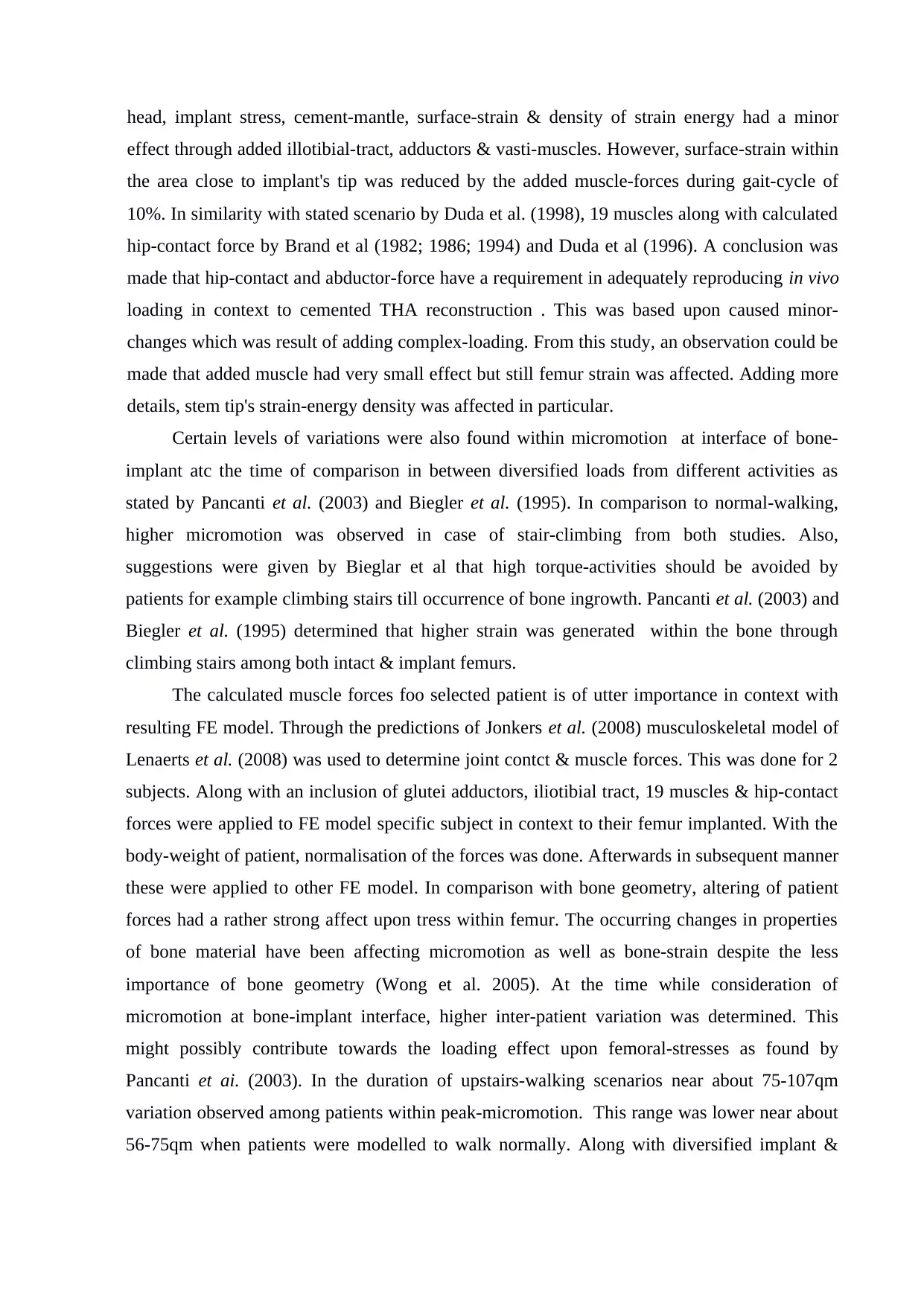
effect through added illotibial-tract, adductors & vasti-muscles. However, surface-strain within
the area close to implant's tip was reduced by the added muscle-forces during gait-cycle of
10%. In similarity with stated scenario by Duda et al. (1998), 19 muscles along with calculated
hip-contact force by Brand et al (1982; 1986; 1994) and Duda et al (1996). A conclusion was
made that hip-contact and abductor-force have a requirement in adequately reproducing in vivo
loading in context to cemented THA reconstruction . This was based upon caused minor-
changes which was result of adding complex-loading. From this study, an observation could be
made that added muscle had very small effect but still femur strain was affected. Adding more
details, stem tip's strain-energy density was affected in particular.
Certain levels of variations were also found within micromotion at interface of bone-
implant atc the time of comparison in between diversified loads from different activities as
stated by Pancanti et al. (2003) and Biegler et al. (1995). In comparison to normal-walking,
higher micromotion was observed in case of stair-climbing from both studies. Also,
suggestions were given by Bieglar et al that high torque-activities should be avoided by
patients for example climbing stairs till occurrence of bone ingrowth. Pancanti et al. (2003) and
Biegler et al. (1995) determined that higher strain was generated within the bone through
climbing stairs among both intact & implant femurs.
The calculated muscle forces foo selected patient is of utter importance in context with
resulting FE model. Through the predictions of Jonkers et al. (2008) musculoskeletal model of
Lenaerts et al. (2008) was used to determine joint contct & muscle forces. This was done for 2
subjects. Along with an inclusion of glutei adductors, iliotibial tract, 19 muscles & hip-contact
forces were applied to FE model specific subject in context to their femur implanted. With the
body-weight of patient, normalisation of the forces was done. Afterwards in subsequent manner
these were applied to other FE model. In comparison with bone geometry, altering of patient
forces had a rather strong affect upon tress within femur. The occurring changes in properties
of bone material have been affecting micromotion as well as bone-strain despite the less
importance of bone geometry (Wong et al. 2005). At the time while consideration of
micromotion at bone-implant interface, higher inter-patient variation was determined. This
might possibly contribute towards the loading effect upon femoral-stresses as found by
Pancanti et ai. (2003). In the duration of upstairs-walking scenarios near about 75-107qm
variation observed among patients within peak-micromotion. This range was lower near about
56-75qm when patients were modelled to walk normally. Along with diversified implant &
Paraphrase This Document
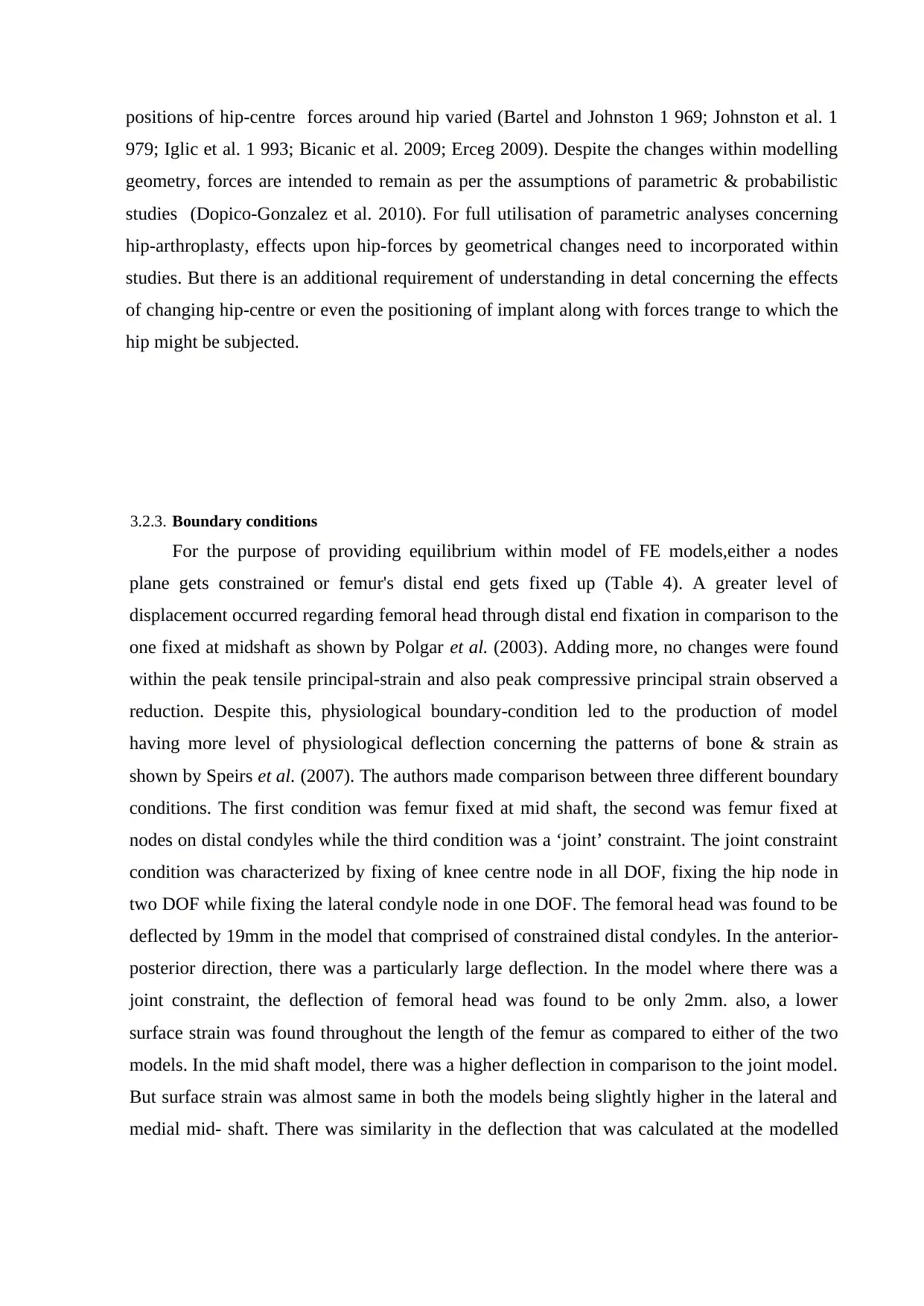
979; Iglic et al. 1 993; Bicanic et al. 2009; Erceg 2009). Despite the changes within modelling
geometry, forces are intended to remain as per the assumptions of parametric & probabilistic
studies (Dopico-Gonzalez et al. 2010). For full utilisation of parametric analyses concerning
hip-arthroplasty, effects upon hip-forces by geometrical changes need to incorporated within
studies. But there is an additional requirement of understanding in detal concerning the effects
of changing hip-centre or even the positioning of implant along with forces trange to which the
hip might be subjected.
3.2.3. Boundary conditions
For the purpose of providing equilibrium within model of FE models,either a nodes
plane gets constrained or femur's distal end gets fixed up (Table 4). A greater level of
displacement occurred regarding femoral head through distal end fixation in comparison to the
one fixed at midshaft as shown by Polgar et al. (2003). Adding more, no changes were found
within the peak tensile principal-strain and also peak compressive principal strain observed a
reduction. Despite this, physiological boundary-condition led to the production of model
having more level of physiological deflection concerning the patterns of bone & strain as
shown by Speirs et al. (2007). The authors made comparison between three different boundary
conditions. The first condition was femur fixed at mid shaft, the second was femur fixed at
nodes on distal condyles while the third condition was a ‘joint’ constraint. The joint constraint
condition was characterized by fixing of knee centre node in all DOF, fixing the hip node in
two DOF while fixing the lateral condyle node in one DOF. The femoral head was found to be
deflected by 19mm in the model that comprised of constrained distal condyles. In the anterior-
posterior direction, there was a particularly large deflection. In the model where there was a
joint constraint, the deflection of femoral head was found to be only 2mm. also, a lower
surface strain was found throughout the length of the femur as compared to either of the two
models. In the mid shaft model, there was a higher deflection in comparison to the joint model.
But surface strain was almost same in both the models being slightly higher in the lateral and
medial mid- shaft. There was similarity in the deflection that was calculated at the modelled
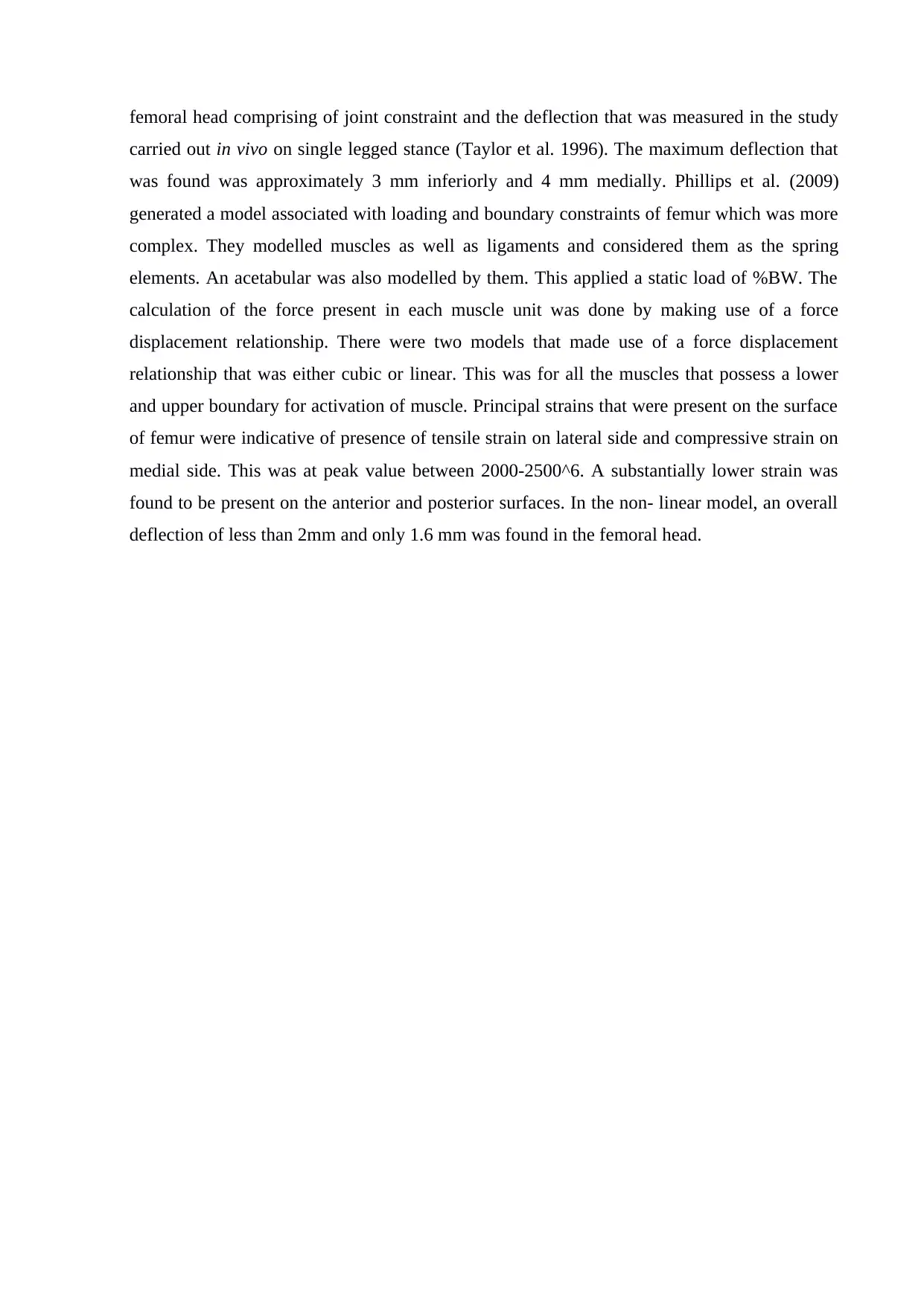
carried out in vivo on single legged stance (Taylor et al. 1996). The maximum deflection that
was found was approximately 3 mm inferiorly and 4 mm medially. Phillips et al. (2009)
generated a model associated with loading and boundary constraints of femur which was more
complex. They modelled muscles as well as ligaments and considered them as the spring
elements. An acetabular was also modelled by them. This applied a static load of %BW. The
calculation of the force present in each muscle unit was done by making use of a force
displacement relationship. There were two models that made use of a force displacement
relationship that was either cubic or linear. This was for all the muscles that possess a lower
and upper boundary for activation of muscle. Principal strains that were present on the surface
of femur were indicative of presence of tensile strain on lateral side and compressive strain on
medial side. This was at peak value between 2000-2500^6. A substantially lower strain was
found to be present on the anterior and posterior surfaces. In the non- linear model, an overall
deflection of less than 2mm and only 1.6 mm was found in the femoral head.
⊘ This is a preview!⊘
Do you want full access?
Subscribe today to unlock all pages.

Trusted by 1+ million students worldwide
Your All-in-One AI-Powered Toolkit for Academic Success.
+13062052269
info@desklib.com
Available 24*7 on WhatsApp / Email
![[object Object]](/_next/static/media/star-bottom.7253800d.svg)
© 2024 | Zucol Services PVT LTD | All rights reserved.

